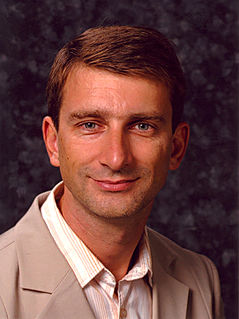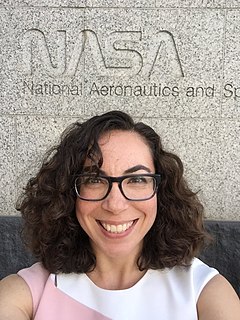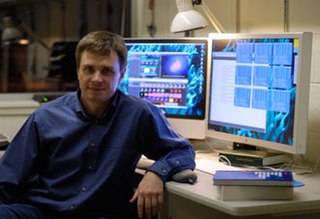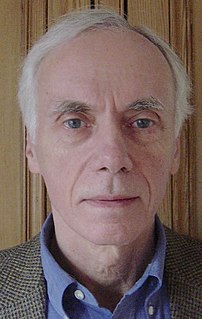Related Research Articles

Extragalactic astronomy is the branch of astronomy concerned with objects outside the Milky Way galaxy. In other words, it is the study of all astronomical objects which are not covered by galactic astronomy.
Astrophysics is a science that employs the methods and principles of physics and chemistry in the study of astronomical objects and phenomena. As one of the founders of the discipline said, Astrophysics "seeks to ascertain the nature of the heavenly bodies, rather than their positions or motions in space–what they are, rather than where they are." Among the subjects studied are the Sun, other stars, galaxies, extrasolar planets, the interstellar medium and the cosmic microwave background. Emissions from these objects are examined across all parts of the electromagnetic spectrum, and the properties examined include luminosity, density, temperature, and chemical composition. Because astrophysics is a very broad subject, astrophysicists apply concepts and methods from many disciplines of physics, including classical mechanics, electromagnetism, statistical mechanics, thermodynamics, quantum mechanics, relativity, nuclear and particle physics, and atomic and molecular physics.
Amy J. Barger is an American astronomer and Henrietta Leavitt Professor of Astronomy at the University of Wisconsin–Madison. She is considered a pioneer in combining data from multiple telescopes to monitor multiple wavelengths and in discovering distant galaxies and supermassive black holes, which are outside of the visible spectrum. Barger is an active member of the International Astronomical Union.
Peter Coles is a theoretical cosmologist at Maynooth University. He studies the large scale structure of our Universe.

Somak Raychaudhury is an Indian astrophysicist. He is the Director of the Inter-University Centre for Astronomy and Astrophysics (IUCAA), Pune. He is on leave from Presidency University, Kolkata, India, where he is a Professor of Physics, and is also affiliated to the University of Birmingham, United Kingdom. He is known for his work on stellar mass black holes and supermassive black holes. His significant contributions include those in the fields of gravitational lensing, galaxy dynamics and large-scale motions in the Universe, including the Great Attractor.

Simon David Manton White, FRS, is a British astrophysicist. He was one of directors at the Max Planck Institute for Astrophysics before his retirement in late 2019.
George Petros Efstathiou is a British astrophysicist who is Professor of Astrophysics (1909) at the University of Cambridge and was the first Director of the Kavli Institute for Cosmology at the University of Cambridge from 2008 to 2016. He was previously Savilian Professor of Astronomy at the University of Oxford.

Uroš Seljak is a Slovenian cosmologist and a professor of astronomy and physics at University of California, Berkeley. He is particularly well-known for his research in cosmology and approximate Bayesian statistical methods.

Simon John Lilly FRS is a Professor in the Department of Physics at ETH Zürich.

Warrick John Couch is an Australian professional astronomer. He is currently a professor at Swinburne University of Technology in Melbourne. He was previously the Director of Australia's largest optical observatory, the Australian Astronomical Observatory (AAO). He was also the President of the Australian Institute of Physics (2015–2017), and a non-executive director on the Board of the Giant Magellan Telescope Organization. He was a founding non-executive director of Astronomy Australia Limited.

Megan Donahue is an American astronomer who studies galaxies and galaxy clusters. She is a professor of physics and astrophysics at Michigan State University, and the president of the American Astronomical Society for the 2018–2020 term.
Nia Imara is an American astrophysicist, artist, and activist. Imara's scientific work deals with galactic mass, star formation, and exoplanet detection. Imara was the first African-American woman to earn a PhD in astrophysics at the University of California, Berkeley and was the inaugural postdoctoral fellow in the Future Faculty Leaders program at Harvard University. In 2020, Imara joined the University of California, Santa Cruz as an Assistant Professor in the Department of Astronomy.
Barbara A. Williams is an American radio astronomer and the first African-American woman to earn a PhD in astronomy. Her research largely focused on compact galaxy groups, in particular observations of their emissions in the H I region in order to build up a larger scale picture of the structure and evolution of galaxies. Williams was named as the Outstanding Young Woman of America in 1986 and is currently a retired Associate Professor in the Department of Physics and Astronomy at the University of Delaware.

Erika Tobiason Hamden is an American astrophysicist and Assistant Professor at the University of Arizona and Steward Observatory. Her research focuses on developing ultraviolet (UV) detector technology, ultraviolet–visible spectroscopy (UV/VIS) instrumentation and spectroscopy, and galaxy evolution. She served as the project scientist and project manager of a UV multi-object spectrograph, FIREBall-2, that is designed to observe the circumgalactic medium (CGM). She is a 2019 TED fellow.
Jessica K. Werk is an American astronomer and an associate professor in the Department of Astronomy at the University of Washington. Her work includes the study of intergalactic and interstellar media. Werk was a Hubble fellow at the University of California, Santa Cruz from 2013 to 2016, and won the $65,000 Sloan Fellowship in 2018. Her research focuses on the role of gas in the formation and evolution of galaxies and the intergalactic medium, primarily through spectroscopic observations in the optical and ultraviolet.
Misty C. Bentz is an American astrophysicist and Professor of Physics and Astronomy at Georgia State University. She is best known for her work on supermassive black hole mass measurements and black hole scaling relationships.

Peter Lawrence Capak is currently the Architect of Perception Systems at the Oculus division of Facebook. His current focus is developing machine perception technologies, sensors, displays, and compute architectures for the next generation of augmented (AR), mixed (MR) and virtual reality (VR) systems. His research has focused on using physical modeling and advanced statistical methods including artificial intelligence and machine learning to extract information from very large multi-wavelength (hyper-spectral) data sets. He has primarily used this to study structure formation in the universe, cosmology, and the nature of dark matter and dark energy.

Dr. Alexey Vikhlinin is a Russian-American astrophysicist notable for achievements in the astrophysics of high energy phenomenon, namely galaxy cluster cosmology and the design of space-based X-ray observatories. He is currently a Senior Astrophysicist and Deputy Associate Director of the High Energy Astrophysics Division at the Smithsonian Astrophysical Observatory, part of the Center for Astrophysics | Harvard & Smithsonian in Cambridge, Massachusetts. He is the Science and Technology Definition Team (STDT) Community Co-Chair for the Lynx X-ray Observatory, a NASA-funded Large Mission Concept Study under consideration by the 2020 Decadal Survey on Astronomy and Astrophysics.

Péter István Mészáros is a Hungarian-American theoretical astrophysicist, best known for the Mészáros effect in cosmology and for his work on gamma-ray bursts.
Alyson Brooks is an American theoretical astrophysicist and professor at Rutgers University. She uses large-scale simulations to determine how galaxies form.
References
- ↑ "G. Mark Voit" . Retrieved Oct 10, 2017.
- ↑ "Mark Voit". aaas.org. Retrieved May 14, 2017.
- ↑ "G. Mark Voit". msu.edu. Retrieved May 14, 2017.
- ↑ "G. Mark Voit". msu.edu. Retrieved May 14, 2017.
- ↑ "G. Mark Voit". msu.edu. Retrieved May 14, 2017.
- ↑ "G. Mark Voit" . Retrieved May 14, 2017.
- 1 2 3 Curriculum vitae , retrieved 2017-10-10